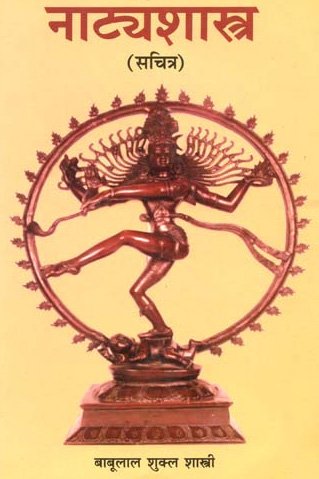Angahara, Aṅgahāra, Anga-hara, Aṅgahara, Amgahara: 11 definitions
Introduction:
Angahara means something in Hinduism, Sanskrit. If you want to know the exact meaning, history, etymology or English translation of this term then check out the descriptions on this page. Add your comment or reference to a book if you want to contribute to this summary article.
In Hinduism
Natyashastra (theatrics and dramaturgy)
Source: Wisdom Library: Nāṭya-śāstraAṅgahāra (अङ्गहार, “movement of limbs”) refers to “major dance figures” consisting of minor dance figures (karaṇas), according to the Nāṭyaśāstra 4.13. It was first presented and performed before Śiva in the Himalayan region, in the presence many Bhūtas, Gaṇas and beautiful caves and waterfalls.
These are the thirty-two different kinds of aṅgahāras:
- sthirahasta,
- paryastaka,
- sūcividdha,
- apaviddha,
- ākṣiptaka,
- udghaṭṭita,
- viṣkambha,
- aparājita,
- viṣkambhāpasṛta,
- mattākrīḍa,
- svastikarecita,
- pārśvasvastika,
- vṛścika,
- (vṛścikāpasṛta) bhramara,
- mattaskhalitaka,
- madavilasita,
- gatimaṇḍala,
- paricchinna,
- parivṛttarecita,
- vaiśākharecita,
- parāvṛtta,
- alātaka,
- pārśvaccheda,
- vidyudbhrānta,
- uddhṛtaka,
- (udvṛttaka) alīḍha,
- recita,
- ācchurita,
- ākṣiptarecita,
- saṃbhrānta,
- apasarpita,
- Ardhanikuṭṭaka.

Natyashastra (नाट्यशास्त्र, nāṭyaśāstra) refers to both the ancient Indian tradition (shastra) of performing arts, (natya—theatrics, drama, dance, music), as well as the name of a Sanskrit work dealing with these subjects. It also teaches the rules for composing Dramatic plays (nataka), construction and performance of Theater, and Poetic works (kavya).
Purana and Itihasa (epic history)
Source: JatLand: List of Mahabharata people and placesAṅgahara (अङ्गहर) is a name mentioned in the Mahābhārata (cf. XIV.8.30, XIV.8) and represents one of the many proper names used for people and places. Note: The Mahābhārata (mentioning Aṅgahara) is a Sanskrit epic poem consisting of 100,000 ślokas (metrical verses) and is over 2000 years old.

The Purana (पुराण, purāṇas) refers to Sanskrit literature preserving ancient India’s vast cultural history, including historical legends, religious ceremonies, various arts and sciences. The eighteen mahapuranas total over 400,000 shlokas (metrical couplets) and date to at least several centuries BCE.
General definition (in Hinduism)
Source: Academia.edu: Some Pearls from the Fourth Chapter of Abhinavabhāratī Table of ContentsAbhinavagupta defines Aṅgahāra (अङ्गहार) and explains it as the process of moving the limbs from one place to another. Because it is loved and practiced by Hara (Śiva), the shadow of his name is incorporated in the term aṅgahāra. It must be understood as the twisting and bending of the limbs in a graceful manner
Languages of India and abroad
Sanskrit dictionary
Source: DDSA: The practical Sanskrit-English dictionaryAṅgahāra (अङ्गहार).—[aṅgaṃ hriyate itastataḥ cālyate yatra, hṛ-ādhāre or bhāve ghañ] gesticulation, movements of the limbs, a dance; अङ्गहारैस्तथैवान्या कोमलै- र्नृत्यशालिनी (aṅgahāraistathaivānyā komalai- rnṛtyaśālinī) Rām.5.1.36. संसक्तैरगुरुवनेषु साङ्गहारम् (saṃsaktairaguruvaneṣu sāṅgahāram) Kirātārjunīya 7.37. Kumārasambhava 7.91.
Derivable forms: aṅgahāraḥ (अङ्गहारः).
Aṅgahāra is a Sanskrit compound consisting of the terms aṅga and hāra (हार).
Source: Cologne Digital Sanskrit Dictionaries: Shabda-Sagara Sanskrit-English DictionaryAṅgahāra (अङ्गहार).—m.
(-raḥ) Gesture, gesticulation. E. aṅga, and hāra taking, moving; also aṅgahāri.
Source: Cologne Digital Sanskrit Dictionaries: Monier-Williams Sanskrit-English DictionaryAṅgahāra (अङ्गहार):—[=aṅga-hāra] [from aṅga] ([Kathāsaritsāgara]) ([cf. Lexicographers, esp. such as amarasiṃha, halāyudha, hemacandra, etc.]) m. gesticulation.
Source: Cologne Digital Sanskrit Dictionaries: Goldstücker Sanskrit-English DictionaryAṅgahāra (अङ्गहार):—[tatpurusha compound] m.
(-raḥ) Gesture, gesticulation. E. aṅga and hāra. Also aṅgahāri.
Source: Cologne Digital Sanskrit Dictionaries: Yates Sanskrit-English DictionaryAṅgahāra (अङ्गहार):—[aṅga-hāra] (raḥ) 1. m. Gesture.
[Sanskrit to German]
Sanskrit, also spelled संस्कृतम् (saṃskṛtam), is an ancient language of India commonly seen as the grandmother of the Indo-European language family (even English!). Closely allied with Prakrit and Pali, Sanskrit is more exhaustive in both grammar and terms and has the most extensive collection of literature in the world, greatly surpassing its sister-languages Greek and Latin.
Kannada-English dictionary
Source: Alar: Kannada-English corpusAṃgahāra (ಅಂಗಹಾರ):—[noun] expression of sentiments by moving the body or part or part of it; gesticulation.
Kannada is a Dravidian language (as opposed to the Indo-European language family) mainly spoken in the southwestern region of India.
See also (Relevant definitions)
Ends with: Sarangahara, Vankahara.
Full-text (+41): Angahari, Nritta, Akshiptaka, Vishkambhapasrita, Acchurita, Apasarpita, Paryastaka, Gatimandala, Parshvaccheda, Paricchinna, Mattaskhalitaka, Madavilasita, Vrishcikapasrita, Sthirahasta, Mattakrida, Ardhanikuttaka, Parshvasvastika, Udvrittaka, Aparajita, Svastikarecita.
Relevant text
Search found 8 books and stories containing Angahara, Aṅgahāra, Anga-hara, Aṅgahara, Amgahara, Aṅga-hāra, Aṃgahāra; (plurals include: Angaharas, Aṅgahāras, haras, Aṅgaharas, Amgaharas, hāras, Aṃgahāras). You can also click to the full overview containing English textual excerpts. Below are direct links for the most relevant articles:
Gati in Theory and Practice (by Dr. Sujatha Mohan)
Representation of Gati with Karaṇas and Aṅgahāras < [Chapter 2 - Concept and technique of Gati]
Technical treatises on Nāṭya (other works) < [Chapter 1 - Nāṭya]
Elements of Āṅgika-abhinaya in Nāṭyaśāstra < [Chapter 1 - Nāṭya]
Natya, the Celestial Art of Ancient India < [July 1939]
Uday Shankar < [July-August 1933]
Art of Srimati Balasaraswati < [July – September, 1979]
The Religion and Philosophy of Tevaram (Thevaram) (by M. A. Dorai Rangaswamy)
Chapter 4.3 - (d) Technical terms used by Arurar in relation to Dance and Music < [Volume 2 - Nampi Arurar and Mythology]
Natyashastra (English) (by Bharata-muni)
Chapter IV - Description of the Class Dance (tāṇḍava)
List of Mahabharata people and places (by Laxman Burdak)
Trishashti Shalaka Purusha Caritra (by Helen M. Johnson)
Appendix 5.1: additional notes < [Appendices]
Appendix 5.2: new and rare words < [Appendices]
Part 9: Attacks by Meghamālin < [Chapter III - Birth, youth, initiation, and omniscience of Śrī Pārśva]